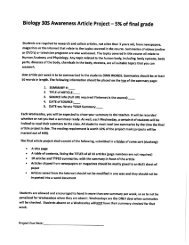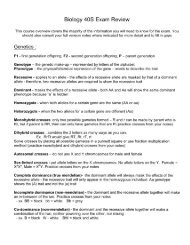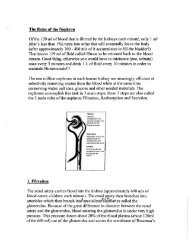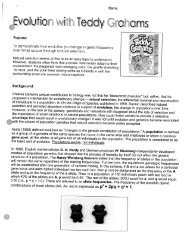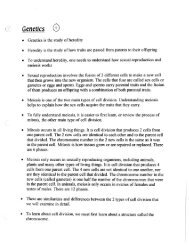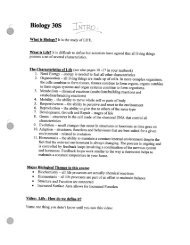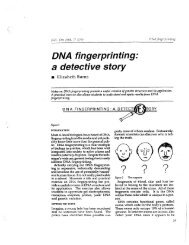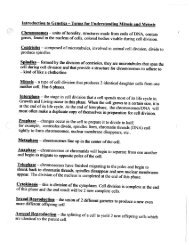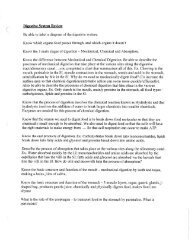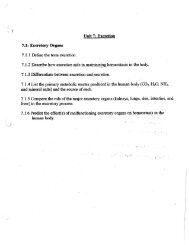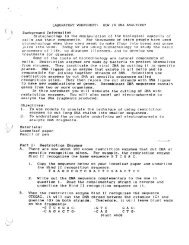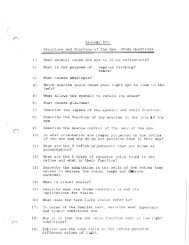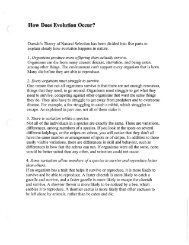Digestion of Carbs, etc.pdf - Mrs Stovel
Digestion of Carbs, etc.pdf - Mrs Stovel
Digestion of Carbs, etc.pdf - Mrs Stovel
Create successful ePaper yourself
Turn your PDF publications into a flip-book with our unique Google optimized e-Paper software.
Figure B-59 THE DIGESTION OF CARBOHYDRATES<br />
polysaccharides<br />
salivary<br />
amylase<br />
breaks up long<br />
chain starch<br />
molecules<br />
small<br />
intestine +<br />
pancreatic<br />
enzymes<br />
maltase<br />
maltose sucrose lactose<br />
disaccharides<br />
I<br />
00 00 00<br />
glucose glucose glucose fructose glucose galactose<br />
CH,OH<br />
O<br />
OH<br />
OH<br />
-<br />
CH,OH<br />
I<br />
ON<br />
O<br />
dehydration<br />
synthesis<br />
maltase<br />
OH hydrolysis<br />
OH<br />
CH2OH<br />
CH,OH<br />
OH<br />
OH<br />
glucose + glucose
Figure B-61 THE DIGESTION OF PROTEINS<br />
pepsin pepsin<br />
polypeptides<br />
peptone<br />
protease<br />
pepsin breaks complex protein chains into shorter lengths called peptones and proteoses<br />
1small intestine<br />
!yn<br />
trypsin<br />
7<br />
chymotrypsin<br />
dipeptides<br />
eatic<br />
_<br />
trypsin and other peptidases break peptones and proteoses into single or double amino acid units'<br />
Lend products<br />
for absorption<br />
Q<br />
Figure B-60 THE DIGESTION OF FATS<br />
liver<br />
produces bile<br />
emulsification<br />
fat droplets<br />
rpancreas<br />
produces<br />
lipase<br />
H2O<br />
glycerol<br />
fat molecules<br />
end products<br />
<strong>of</strong> digestion<br />
glycerol and fatty acids<br />
H<br />
H--C Q^ h_BO----`CQ Ca7Hac<br />
// dehydration<br />
synthesis<br />
H -C^ ------%-C„H, lipase<br />
H--,C H _ _C-C,7H, hydrolysis<br />
H -Cf 0 -`^- C C, 7 a, + H,0<br />
1 //<br />
H--C---0-C© C17H, ± H2O<br />
//<br />
H-C--Q C- ----C,H,5 + Hr0<br />
H<br />
glycerol -3-stearic acid tristearin
Figure 13.11.<br />
The liver, gall bladder,<br />
pancreas, small intestines, and<br />
the ducts which deliver bile and<br />
pancreatic juices to the<br />
duodenum.<br />
Small<br />
^tfst(1<br />
Figure 24.16 Fat <strong>Digestion</strong>:<br />
Emulsification , Fat Absorption,<br />
Bile Salt Recycling. This diagram<br />
shows how a fat globule<br />
floating along in the small intestine<br />
after a meal is emulsified by<br />
bile salts. Bile salts are produced<br />
in the liver, stored in the<br />
gallbladder, and passed down<br />
the bile duct. From fat globules,<br />
bile salts help remove small<br />
groups <strong>of</strong> lipid molecules. which<br />
in turn pass into cells lining the<br />
intestinal wall. The small group<br />
<strong>of</strong> lipid molecules becomes<br />
coated with protein and enters<br />
the lymph and eventually the<br />
blood circulation, and the bile<br />
salts are recycled and stored<br />
once again in the gallbladder.<br />
rats to<br />
lymph to<br />
E arty use
a 12.21 The action <strong>of</strong> some<br />
major pancreatic enzymes<br />
Nuftiem k Product <strong>of</strong><br />
Psrtleie Enzyme D19*01on<br />
t --- --- ws<br />
Maltose<br />
o-a<br />
Dextrin<br />
i►a<br />
Pancreatic Arnytase<br />
Sucrose<br />
Lactose<br />
Trypsin or Chymotrypsin<br />
A ^Ik1A A<br />
Proteose<br />
Protein<br />
Peptone<br />
sAA<br />
Proteose<br />
Ot<br />
*4,4,,k<br />
Peptone<br />
Trypntn or Chymatrypsin<br />
A<br />
Dipeptide<br />
Key<br />
i<br />
Pancreatic Lipase<br />
E and n<br />
n<br />
r Monosacr haride<br />
A Amino Acid<br />
Emulsified Fat<br />
Glycerol<br />
Fatty<br />
Acids<br />
E Gtycsro€<br />
• Fatty Acid
Nutrient<br />
lntermec€iate Products <strong>of</strong> <strong>Digestion</strong><br />
Key<br />
• Monosaccharide<br />
A Ammo Acid<br />
E<br />
Glycerol<br />
8 Fatty Acid<br />
Final Products<br />
<strong>of</strong> Cigestion<br />
Polysaccharide<br />
Salivary<br />
Amylase<br />
and<br />
Pancreatic<br />
Amylase<br />
r-i<br />
Intestinal<br />
Maltase<br />
• •<br />
Maltose Intestinal Glucose Glucose<br />
Sucrose<br />
Sucrose Intestinal Glucose Fructose<br />
Lactase<br />
ems---+ --+ • •<br />
Lactose<br />
Glucose Galactose<br />
Disaccrtarides<br />
Monosaccharides<br />
Protein<br />
PepsineR<br />
Pancreatic<br />
Enzymes<br />
Proteossa<br />
A<br />
Eaeotones<br />
Pancreatic<br />
Enzymes<br />
Dipeatide<br />
Pancreatic<br />
And Intestinal<br />
Enzymes<br />
A<br />
Amino Acids<br />
Ell<br />
0<br />
Bile<br />
(Phys4cal Emulsification<br />
into Smaller Particles)<br />
Pancreatic Lipase<br />
Glycerol<br />
Fatty<br />
Rcids<br />
Fat<br />
Figure 2.7<br />
Chemical digestion <strong>of</strong> major nutrients into absorbable end products.
3. ABSORPTION<br />
There are 2 types <strong>of</strong> absorption that occur in the digestive system. One is the absorption <strong>of</strong><br />
nutrients (the small molecular end-products <strong>of</strong> digestion, as well as vitamins, minerals and water)<br />
which occurs in the small intestine and the other is the absorption <strong>of</strong> the large quantities <strong>of</strong> water<br />
that is part <strong>of</strong> the leftover food/waste material which occurs in the large intestine.<br />
A. ABSORPTION IN THE SMALL INTESTINE<br />
Once all <strong>of</strong> the food material has been broken down into small absorbable molecules, it can be sent<br />
to the blood stream and the blood will deliver the nutrients to all body cells.<br />
The increased amount <strong>of</strong> surface area (in the lumen, or interior lining <strong>of</strong> the SI) that is created by<br />
the villi and microvilli means that the amount <strong>of</strong> surface which has the ability to absorb the<br />
nutrients will also be increased.<br />
More absorptive surface means that nutrient uptake by the blood will occur faster.<br />
Each villus (singular <strong>of</strong> villi) contains: (also refer to the diagrams)<br />
• A capillary network - these are very small blood vessels which are able to absorb<br />
monosaccharides, amino acids and nucleotides.<br />
• A lacteal - these are small lymph vessels which absorb fatty acids and glycerol<br />
• Mucus cells - these provide lubricant to the lumen(interior cavity) <strong>of</strong> the SI.<br />
• Microvilli -- these are microscopic finger-like projections which further increase the<br />
surface area for greater absorptive capacity<br />
Most, but not all, nutrients are absorbed as they pass through the Si.<br />
ABSORPTION IN THE LARGE INTESTINE (COLON)<br />
"Leftovers" (undigested food) from the ST enter the LI through the ileocaecal sphincter.<br />
There are 3 sections: ascending cold<br />
ansverse colon and descending colon.<br />
The main. function <strong>of</strong> the LI/colon is to re-absorb water from the leftovers. This is an effort to<br />
conserve water and compact the now "waste" material so that it can be stored in the lowest and<br />
last portion <strong>of</strong> the LI, called the rectum.<br />
Waste food materials are called FECES. Feces are excreted from the rectum through the anal<br />
sphincter (anus) by a process known as defecation.
OTHER THINGS TONOTE:<br />
• E. coli bacteria living in the LI help breakdown and s<strong>of</strong>ten waste material<br />
• E. coli also produce vitamin B and K from fibre (cellulose)<br />
• Fibre is not a nutrient due to the fact that we do not possess the enzymes that are necessary for<br />
its digestion.<br />
Fibre is however, considered to be a very important component in our diet. Fibre acts like a<br />
sponge in the LI, allowing the feces to hold on to some water and thus allow it to stay s<strong>of</strong>t<br />
(prevents constipation). Fibre also serves as a "scrub brush" to clean the intestines as its rough<br />
surfaces pass along the lining <strong>of</strong> the intestines. This is thought to help prevent cancer. Also,<br />
fibre adds bulk to the waste material both by its own presence and by the fact that it holds on<br />
to water. This added bulk serves to raise the level <strong>of</strong> peristalsis that occurs in the intestines<br />
and to "speed up" the conveyor belt. This means that materials can be moved to the site <strong>of</strong><br />
removal quicker and this is also thought to have a roll both in the prevention <strong>of</strong> constipation<br />
and in the prevention <strong>of</strong> cancer.<br />
• Exlax is a laxative. Laxatives are chemicals/drugs which increase the rate <strong>of</strong> peristalsis.<br />
Increased peristaltic action means that materials pass through the digestive tract at a faster rate.<br />
The faster rate prevents both digestion and absorption <strong>of</strong> both food and water from occurring<br />
at their normal rates. As a result, the feces pass through the system in approximately the same<br />
liquid state as chyme.<br />
• Other chemicals/drugs can also affect the digestive process, as can environmental influences<br />
such as stress, infections (flu viruses), and the quality <strong>of</strong> food and water (free from poisons or<br />
pathogens).
Mesentery. A membrane<br />
that supports the ---,<br />
small intestine<br />
and carries<br />
blood vessels, <strong>etc</strong>. I I k %4 ►\ \ \\\^<br />
The tube <strong>of</strong> the<br />
small intestine<br />
Mucosa . Muscle layers. Circular<br />
Contains glands. and longitudinal muscles<br />
contract to move the<br />
Villi for absorption food along the tube<br />
by peristalsis.<br />
lining <strong>of</strong> small<br />
j intestine<br />
A SECTION THROUGH<br />
THE SMALL INTESTINE<br />
arteriole lymph vessel venule leaving<br />
entering<br />
villus<br />
villus
Nutrition : small intestine<br />
05.005<br />
A Section <strong>of</strong> ileum<br />
8 Part <strong>of</strong> ileum wall<br />
showing villi<br />
C Villus (vertical section)<br />
1 Circular muscle<br />
2 Ridge coverad with vitti<br />
3 longitudinal muscle<br />
4 Mucosa<br />
% Thin muscle layer<br />
Submucosa<br />
7 Villas<br />
$ Crypt <strong>of</strong> Lieberkuhn<br />
Arterio4e<br />
It Mucursecretinq cell<br />
11 Epithelium<br />
12 Network <strong>of</strong> blood<br />
capillaries<br />
13 Lacteal (carrying fatty<br />
acids and gfyceroll<br />
14 Vec uee (carrying amino<br />
acids and<br />
rnonosacchandes )
Organ<br />
(Gland)<br />
Name <strong>of</strong> the enzyme<br />
that is produced there<br />
Location <strong>of</strong><br />
enzyme action<br />
Substrate that the<br />
enzyme acts on<br />
Product(s) that<br />
is/are rode ed<br />
Salivary<br />
Glands 1 )<br />
Gastric 1}<br />
Glands<br />
2 )<br />
Crypts <strong>of</strong> 1)<br />
Lieberkuhn<br />
2)<br />
3)<br />
4)<br />
5)<br />
6)<br />
7)<br />
Pancreas 1)<br />
2)<br />
3}<br />
4)<br />
5}<br />
6)<br />
7)<br />
8)-<br />
9)<br />
to }
Food group being digested<br />
Name <strong>of</strong> an enzyme that<br />
digests that type <strong>of</strong> food<br />
I Where the enzyme is made<br />
CARBOHYDRATES<br />
1).<br />
3)<br />
FATS/LIPIDS I)<br />
PROTEINS<br />
I)-<br />
2)<br />
31<br />
S)<br />
6)<br />
NUCLEIC ACIDS 1 1)
Biology. 30, --<strong>Digestion</strong> video<br />
1. Crawfishes' teeth are located in their<br />
2. The amoeba engulfs an entire food particle. It does<br />
this by .<br />
3. Humans eat everything; plants and meat. We are<br />
called<br />
4. All animals this in common--they must<br />
5. Lipids break down into and<br />
.<br />
6. <strong>Digestion</strong> requires chemicals called<br />
7. Lipases break down or<br />
8. Egestion means<br />
9. One organ <strong>of</strong> the digestive system is the<br />
10. and control digestion.<br />
1 1 . Saliva begins the chemical breakdown <strong>of</strong><br />
molecules in the mouth.<br />
12. Food is chewed, pushed to the back <strong>of</strong> the mouth,<br />
and down the .<br />
13. Muscle contractions are also called<br />
14. An is used to see what is going on in<br />
the digestive system.
15. Pepsinogen, once activated by hydrochloric acid, is<br />
called<br />
16. Gastric juice dissolved a strip <strong>of</strong> beef in<br />
0.25 h/0.50 h/1.0 h/1.5 h.<br />
17. The stomach walls are protected from stomach acid<br />
by a<br />
lining.<br />
18. Secretion <strong>of</strong> is controlled by nerves<br />
and hormones.<br />
19. Food is finished being digested in the<br />
20. The small intestine is long.<br />
21. stimulates the pancreas to release<br />
pancreatic juice.<br />
22. Bile emulsifies fat and is stored in the<br />
23. The inner surface <strong>of</strong> the small intestine is lined<br />
with<br />
24. The small intestine is long.<br />
25. The villi function to increase<br />
.<br />
26. Fat is absorbed the same way as proteins and<br />
simple sugars; T/F<br />
27. The blood carries food to the liver, which acts as a<br />
28. live inside the colon.<br />
29. Water is removed from/added to the colon.<br />
30. The large intestine is long.



